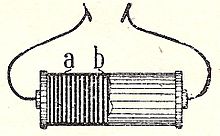Zambonis Column
The Zambonis Column , also Zambonische Column , is a dry cell battery that was invented in 1812 by the Italian Catholic priest and physicist Giuseppe Zamboni .
Basic structure
The Zamboni column consists of a very large number of paper sheets (a) placed one on top of the other and coated with alternating thin layers (b) of two different metals. The two different metals touch each other. The whole thing is hermetically sealed in a tube. Like the voltaic column , the Zambonis column is based on the electrochemical series of voltages . In this case the two different metals that make up the galvanic element are tin and copper bronze , each applied to paper as a dry element . The residual moisture still present in the paper serves as the electrolyte .
Practical execution
In a practical embodiment, for example, the two metals tin and copper bronze can be used. Thin and strong paper is coated on one side with either tin or bronze and layered with the metal sides on top of each other. Variants later appeared in which the other side of the paper was coated with a fine slurry of manganese dioxide, as in the case of zinc-carbon batteries . Discs with a diameter of about 2 cm are punched out of the paper prepared in this way, which are stacked in a 15 cm long glass or celluloid tube of the same diameter and compressed by a helical spring. The approximately 1200 pieces of paper each form an electrochemical element and - when they are stacked in series - deliver a voltage of around 1000 volts. However, the load capacity is very low and lies in the nanoampere range.
The column became famous because it served as a drive for an electrostatically driven pendulum that "never has to be opened". Such Zambon pendulums worked for up to 147 years without changing the battery. A kind of electroscope could be developed from this pendulum (see illustration): The wires c and d connect the horizontally lying zamboni column with the plates a and b.
- “A glass bell is put over the two pole plates, from the curve of which a thin gold leaf hangs down between the poles, attached to a brass rod with a ball on top. If the gold leaf is brought into contact with one, say, the positive pole, after it has been charged with positive electricity, it is repelled and drawn over to the negative pole; After it has given up its positive electricity to the latter and has taken up negative electricity for it, it is repelled by it and attracted by the positive pole, and in this way goes back and forth between the two pole plates; such an “electric perpetual motion machine ” can stay in motion for years. If you move the pole plates so far apart that this game stops and the gold leaf, equally strongly influenced by both poles, hangs down in equilibrium in the middle between the two, the apparatus forms a sensitive electroscope , Fechner's column electroscope . If you approach the button with a weakly electrically charged body, the gold leaf is attracted to the opposite electrical pole of the Zambonian column and its rash reveals not only the existence but also the type of electricity present on the approaching body. "
swell
- Giuseppe Zamboni : Writing about improvements that he has made to his electric column . 1816.
- Massimo Tinazzi: The correspondance between Alessandro Volta and Giuseppe Zamboni about the realization of the "dry pile" . In: Nuova Voltiana , Vol. 5 (2003), pp. 91-103.
- Julius K. von Yelin: Experiments and observations for a closer knowledge of the Zambon dry column . Lentner publishing house, Munich 1820.
- Radio technology 24/1948.
Individual evidence
- ^ Meyers Konversations-Lexikon , 4th edition from 1888–1890, Zambonische column


